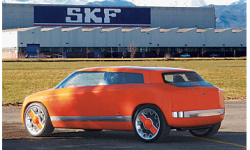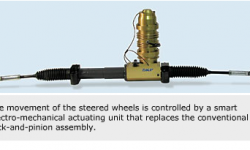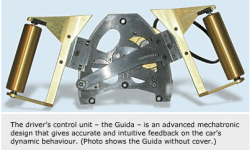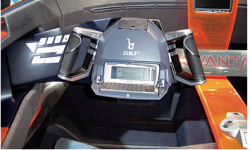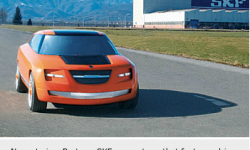
Novanta brings drive-by-wire closer to the automotive market
Drive-by-wire technologies for car designs are moving ever closer to being incorporated into marketable products.
The Bertone-SKF Novanta concept car – an elegant and thought-provoking design that encompasses control by a sophisticated drive-by-wire network – has been awarded “best prototype car” for its incorporation of innovative technology at the 2002 Michelin Bibendum Challenge. This is the annual showcase for environmental and technically advanced vehicles.
For SKF and Bertone, the event has provided an opportunity to put a “concept” on the road. This concept offers a solid example of the way in which drive-by-wire technology fits with the idea of technology combined with environmental responsibility, as promoted by the Challenge. It also demonstrates the opportunities of a modern, more socially aware approach to transportation.
The 2002 Michelin Challenge was held at several locations in Germany and France, culminating at “Le Mondial de l’Automobile 2002,” the Paris International Motor Show.
The concept car has been shown by scientific research to be a valid design, and a strong market has been identified. The next major hurdle is to gain approval from the various national and international standards organisations whose task it is to ensure public safety and approve the wider acceptance of new technologies. The image of the Novanta concept car in front of the European Parliament in Strasbourg testifies, in a symbolic way, that the first move towards commercial advanced technologies for sustainable transport systems has been made.
Drive-by-wire experience
On September 23, 2002, several comparative tests were carried out at the Hockenheim F1 Grand Prix circuit. The Novanta is based upon the experience of the first Bertone-SKF drive-by-wire concept car – the Filo. The new design and driving behaviour of the Novanta further builds on Filo and underlines the growing maturity and reliability of this advanced technology. When compared with the Bertone-SKF Filo, the Novanta demonstrates much-improved steering feedback and feel, as well as improvements in the braking system and transmission interfacing.
“We are proud of the contribution that by-wire technology provides in terms of both active and passive safety (e.g., the steering column has been eliminated) as well as of the sporty spirit of the design, which doesn’t compromise on comfort,” says Filippo Zingariello, vice president of SKF’s Drive-by-Wire business unit. “The heart of the system is the smart electro-mechanical actuating unit (SEMAU), which very obviously demonstrates all of its functionality in a provocative way.”
The driver’s control unit – the Guida – has been significantly refined, compared with the Filo. Position and load sensors incorporated in the unit send a continuous flow of data to the actuator control units of the smart actuating units along a “fault tolerant” communication network. The two interlinked steering yokes have a maximum rotation of 20 ° about the centre, straight-ahead, position, controlling the movement of the steered wheels through a smart actuation unit that replaces the conventional rack-and-pinion assembly. The movement of the Guida’s yokes cause greater movement of the steered wheels at lower vehicle speeds, the sensitivity reducing as vehicle speed increases. An accurate and intuitive feedback on the car’s dynamic behaviour is crucial for driver comfort and, above all, for safety.
The braking system, developed in cooperation with Brembo of Italy, incorporates callipers with an integrated electro-mechanical actuating unit and operates on each wheel independently, helping to ensure better car control. Thanks to very short signal propagation and system reaction times, a “recovery mode” can effectively detect any failure immediately. If such an unlikely event should occur, dynamic vehicle-control software would activate, avoiding the risk of a dangerous skid.
The shift operations of the automatic gearbox are automated through a dedicated logical controller. The controller sends the signals generated by control buttons – located on the support arm of the Guida – to a smart electro-mechanical actuating unit.
The SEMAUs are vital components of the vehicle. Integrated in a network, they continuously monitor the whole vehicle, each actuator control unit and the electrical power supply levels. The vehicle uses both the conventional 14-volt and the emerging 42-volt standard. In case of electronic failure, automatic node reconnection is made in milliseconds.
Radical new approach
The vehicle has the character of an aggressive executive saloon with a radical new approach for its internal architecture. As the driver enters the Novanta, he or she sees neither steering wheel nor steering column. The Guida is concealed and pivots out from the door’s inner panel, revealing a compact, neat and ergonomic driving device, offering driving comfort, pleasure and a high level of safety.
In the vision of Bertone’s stylists, the increasingly virtual relations between driver and car become deeper with the introduction of a new driving concept: a smart interface rather than the traditional wheel and gear selector. “Here our concept has reached the upper limits,” says Roberto Piatti, Stile Bertone’s managing director. “From the point of view of interior space design, the Guida must remain perfectly hidden, at least until the driver decides to start the engine.”
Apart from the Guida, the only interface with the vehicle lies hidden behind a luminous strip that runs the entire length of the passenger compartment. With a light finger touch on the central orange screen, it is possible to interact with a Nokia Communicator. The large dashboard is a true smart navigation system. It incorporates a miniature fingerprint scanner – a unique “password” used to start the vehicle and activate the car’s nerve system. Data about individual driving preferences and seat position, air conditioning, refuelling reminders, technical checks and even music can be stored. The large interior space enhances the sound system. A compact module of Bose Corporation’s surround-sound system delivers high-quality sound reproduction. Thanks to this sophisticated biometric system, maximum on-board customisation is achieved.
Supported by sophisticated options, a trip can start with nothing more complex than the touch of a finger on the scanner.
SKF team
An SKF team of 12 people was involved in the project, drawn from specialised areas within the overall SKF Group: Drive-by-Wire (Automotive Division), Transrol (Industrial Division) and Sensorised Bearings (Electrical Division).The work was handled in the Airasca production plant.
To complete the project it was necessary to integrate it with further technological content covering both mechanical components and software. The result has been higher comfort and safety levels. If Filo was positively surprising for the introduction of innovative smart electro-mechanical actuating units into steering, braking and transmission systems with integrated redundancy, then Novanta has now convinced even the most sceptical drivers about speed and performance of various by-wire functions.
The global concept falls into SKF’s future vision for vehicle design. It reflects the move towards a new driving philosophy. For sports car-orientated vehicles, the driving approach is still bound up with the tactile feel between driver and mechanical interfaces – the steering and gearshift, for example, so traditional driver/vehicle interfaces will remain unchanged for some time. The significant changes will take place in areas hidden from normal view. Drive-by-wire systems will be fitted, but with what appears to be a more conventional driver interface. The more radical changes that this technology offers for the re-appraisal of a car’s interior may take longer to be accepted.
The Novanta’s sports body is designed on a SAAB 9-5 three-litre V6 platform. The proposal of a classic executive saloon has been made to get across to the public the fact that drive-by-wire technology is not a momentary trend, but a technology in which SKF and Bertone strongly believe.
Development of mobility – mainly during the past century – represents one of mankind’s biggest breakthroughs, an extraordinary factor of economic and social growth. Based on forecasts of steady and relentless growth in car ownership worldwide, new vehicle concepts must be developed to ensure sustainable and environmentally acceptable solutions to transportation needs.


